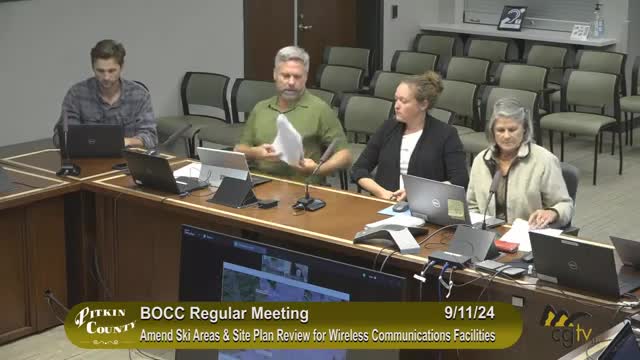Health expert warns of serious risks from 5G towers
September 11, 2024 | Pitkin County, Colorado
This article was created by AI summarizing key points discussed. AI makes mistakes, so for full details and context, please refer to the video of the full meeting. Please report any errors so we can fix them. Report an error »

In a recent government meeting, discussions centered around the installation of new telecommunications infrastructure, specifically the placement of 5G towers and their potential health impacts. A key point of contention was the proposed 10-foot perimeter around structures, including trees and brush, which aims to minimize environmental disruption during installation.
Concerns were raised regarding the provision of electricity to these towers. Officials clarified that if a tower is within 250 feet of an existing transformer, they would utilize that power source; otherwise, new transformers would be installed at each site. This process will involve digging trenches, which could lead to significant surface damage in the areas where construction occurs. Efforts are being made to use pre-disturbed areas to mitigate environmental impact.
Public health implications of 5G technology were a major focus, particularly highlighted by Tom Lankering, a member of the state 5G committee. Lankering expressed alarm over scientific studies linking radio frequency radiation exposure from wireless sources, including cell towers, to serious health risks such as cancer, DNA damage, and neurological issues. He criticized the Federal Communications Commission (FCC) for failing to update safety guidelines that have remained unchanged since 1996, despite advancements in technology and mounting evidence of health risks.
Lankering emphasized the need for a thorough examination of the health effects associated with 5G towers, arguing that the community's health should be prioritized alongside visual and environmental impacts. He pointed out that the cumulative exposure to electromagnetic fields (EMFs) poses significant risks, including increased permeability of the blood-brain barrier, which could have long-term health consequences.
The meeting concluded with a call for further public input and a commitment to address these pressing health concerns as the project moves forward.
Concerns were raised regarding the provision of electricity to these towers. Officials clarified that if a tower is within 250 feet of an existing transformer, they would utilize that power source; otherwise, new transformers would be installed at each site. This process will involve digging trenches, which could lead to significant surface damage in the areas where construction occurs. Efforts are being made to use pre-disturbed areas to mitigate environmental impact.
Public health implications of 5G technology were a major focus, particularly highlighted by Tom Lankering, a member of the state 5G committee. Lankering expressed alarm over scientific studies linking radio frequency radiation exposure from wireless sources, including cell towers, to serious health risks such as cancer, DNA damage, and neurological issues. He criticized the Federal Communications Commission (FCC) for failing to update safety guidelines that have remained unchanged since 1996, despite advancements in technology and mounting evidence of health risks.
Lankering emphasized the need for a thorough examination of the health effects associated with 5G towers, arguing that the community's health should be prioritized alongside visual and environmental impacts. He pointed out that the cumulative exposure to electromagnetic fields (EMFs) poses significant risks, including increased permeability of the blood-brain barrier, which could have long-term health consequences.
The meeting concluded with a call for further public input and a commitment to address these pressing health concerns as the project moves forward.
View full meeting
This article is based on a recent meeting—watch the full video and explore the complete transcript for deeper insights into the discussion.
View full meeting
